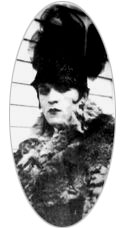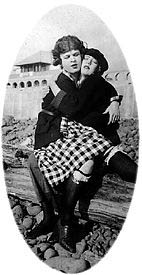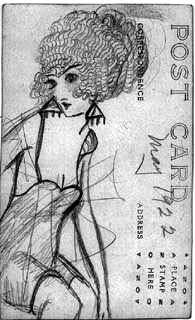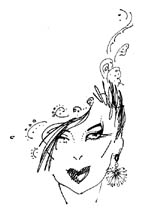TGF Re-Run: Flaming Youth
From time to time we dip back into the TGF Archives and bring back an article from the good old days. Today we re-run a piece by TGF contributors Ms. Bob and Carol Kleinmaier. Crosssdressers have always enjoyed having their pictures taken. Meet some of them in Flaming Youth.
By Ms Bob and Carol Kleinmaier
 Was the camera invented by a crossdresser? If not, it should have been. No group takes, saves, exchanges or publishes more photos of themselves than crossdressers. Actors and politicians have their photos taken on a daily basis; that’s part of the job. They don’t cherish and horde each image. Families fill photo albums with loved ones and vacations, but not photos of themselves posing in motel rooms in front of drawn drapes. Narcissus had still water to reflect his beauty, but for the crossdresser the camera is the perfect mirror.
Was the camera invented by a crossdresser? If not, it should have been. No group takes, saves, exchanges or publishes more photos of themselves than crossdressers. Actors and politicians have their photos taken on a daily basis; that’s part of the job. They don’t cherish and horde each image. Families fill photo albums with loved ones and vacations, but not photos of themselves posing in motel rooms in front of drawn drapes. Narcissus had still water to reflect his beauty, but for the crossdresser the camera is the perfect mirror.
The evidence is everywhere. Let’s examine a prominent publication promoting male pulchritude, Lady Like #30. In its 48 pages there are 142 photos of crossdressers. Crossdressers appear on all but 11 pages and most of those pages feature photos of high heels, breast forms or women modeling clothing intended for crossdressers. Were 142 photos enough? Maybe not. Publisher JoAnn Roberts apologized for the lack of photos in the “Letters to the Editor” section, saying they were damaged before they could be printed.
The “Letters to the Editor” tell us plenty about the importance of photos. Six out of ten letters mention photos. One reader, Jeri, wrote that “the first thing I do when I receive a new issue of Lady Like is scan the pages with anxious anticipation, hoping that I was included in the Mirror Mirror section.” Mirror Mirror, always the magazine’s longest feature, is composed of readers’ photos.
But, not all is vanity. It seems Lady Like readers enjoy seeing the photos of other queens, too. Letter writer Edith offered to buy photos of other crossdressers by the “10’s or 20’s.” And in the previous issue, #29 (160 photos), Elaine offered “an unsolicited suggestion…more photos of your readers.” Would 200 photos be enough in 48 pages? 300? Can there ever be enough?
Love of ones own feminine image no doubt inspired these home photos from the 1920’s. We crossdressers haven’t changed all that much. The surprise is that we don’t see more old photos. But, closeted crossdressers, especially in less enlightened times, may have destroyed their photos as they get older, rather than risk detection after their death. (This is how one senior crossdresser explained selling his collection of magazines to me in 1992.) And many a wife or heir has burned secreted wardrobes, treasured theater programs and especially the scandalous photos of Daddy in dresses.
 Though these photos have survived, their story did not. There are very few facts available. These are from a set of 18 photos purchased from a book and ephemera dealer in the San Francisco Bay area. All he would say was that he bought them from another dealer who bought them at some kind of sale in the Pacific Northwest. (Dealers can be so coy.) Like many photos from the 1920s, these have a place for address and message on the back in case you wanted to use them as post cards, though I doubt these ever went through the mail.
Though these photos have survived, their story did not. There are very few facts available. These are from a set of 18 photos purchased from a book and ephemera dealer in the San Francisco Bay area. All he would say was that he bought them from another dealer who bought them at some kind of sale in the Pacific Northwest. (Dealers can be so coy.) Like many photos from the 1920s, these have a place for address and message on the back in case you wanted to use them as post cards, though I doubt these ever went through the mail.
Lacking the facts let’s call the male transvestite Bea when he’s in drag, in honor of ’20s star Beatrice Lillie and Ben when he’s in drab. (drag = dressed as a girl, drab = dressed as a boy) From the photos of Ben in drab we can learn several things. He is a young man. If he were a girl, he’d be a flapper. But, as a man he’d be called a “flaming youth.” From a close-up, which isn’t printed here, it seems he follows several styles associated with the idle college boys of this era. He plucks his eyebrows and we think we detect some traces of make-up; a bit of blush, some shadow, even a hint of lipstick. His clothes are tailored and in one photo he’s holding a long cigarette holder. In drab he’s more relaxed. He smiles more broadly. As Bea he seems more serious, self-conscious and reserved.
 The crossdressing woman we’ll call Pete after Peter Pan. Her style of dress is common for women impersonating boys on stage and screen. Silent film star Mae Murray wore a similar guise in the 1918 film “Danger, Go Slow,” as did Mary Pickford in “The Hoodlum” from 1919. Ben/Bea seems a bit taller than Pete and, since Pete’s coat sleeves are rolled-up, we might wonder if Pete borrowed Ben’s coat?
The crossdressing woman we’ll call Pete after Peter Pan. Her style of dress is common for women impersonating boys on stage and screen. Silent film star Mae Murray wore a similar guise in the 1918 film “Danger, Go Slow,” as did Mary Pickford in “The Hoodlum” from 1919. Ben/Bea seems a bit taller than Pete and, since Pete’s coat sleeves are rolled-up, we might wonder if Pete borrowed Ben’s coat?
Bea and Pete are out about their crossdressing to each other and the unknown photographer. One spring day, May, 1922, this little support group went to the beach. What an exciting outing it must have been! It was early in the season and the beach was deserted. Bea had a fully matching ensemble: checkered dress, wig, hat, coat, purse, low heeled shoes, and even a parasol. Bea seems a bit reserved. Though she honors us with a little smile when standing next to the jaunty Pete.
On the back of one photo is a drawing of an idealized 1920’s flapper. Bea’s work? Perhaps. We know several crossdressers who draw pictures of fabulous women. Candy Darling, Andy Warhol’s superstar, did this. There are many pages of her drawings in the recently published diary, My Face for the World to See. Doris Fish, San Francisco’s reigning drag diva during the 1980’s, would doodle incessantly while talking on the phone. She didn’t do full figures, usually faces or even just glamorous eyes. Candy drew things like this also. You’ll have to buy Candy’s book to see her drawings, but here we have two drawings by crossdressers done about 65 years apart, one by Doris and one by Bea, if Bea is our unknown artist. Something that can be said is that they both draw rather well.
 Notice the little details in Bea’s outfit, like the lace garters revealed in Pete embrace. What do you think? Is Bea wearing woman’s undergarments? Have you ever heard the old Transgendered Wives Tale? “You can tell a transvestite from a drag queen by their undies.” A drag queen will wear men’s jockeys, but a transvestite will be femme from the skin out.
Notice the little details in Bea’s outfit, like the lace garters revealed in Pete embrace. What do you think? Is Bea wearing woman’s undergarments? Have you ever heard the old Transgendered Wives Tale? “You can tell a transvestite from a drag queen by their undies.” A drag queen will wear men’s jockeys, but a transvestite will be femme from the skin out.
A year later Bea’s at it again. It’s August, 1923 and this time she stays near the house. All the photos are taken on the porch and in the yard. Is it the same photographer as last year? Or is Pete behind the lens? Perhaps the photographer is someone else? An unknown fourth person. Has Bea coming out to more people?
She still looks so serious in most of the photos. Though we do get a small smile in the pose on the porch steps. Her outfits are a bit more revealing. In one shot she bares some skin and poses seductively with a coat draped around her white shoulders.
The drab photos must have been shot first. Virtually every transition sequence starts in the biological gender. Anyway, who would want to get all dressed and made-up and not have any time to flounce around afterward? Waste of good drag, that.
Though we can guess a few things about Bea and Pete, they remain largely a mystery. There’s always the hope that a reader may recognize them or the location. “My God! Look at this, Marge. Its Uncle Harry and Aunt Phyllis at Bon-bon Beach!!” But, that doesn’t seem very likely. All we really know is that Pete and Bea, our spiritual ancestors, went to the beach about 75 years ago. And Bea enjoyed dressing up and taking photos so much that she posed again a year later.
Ms. Bob has been collecting transgender history for over 35 years: newsletters, magazines, photographs, unpublished manuscripts, and ephemera, such as posters, phonograph records, theatre programs, matchbook covers, the list goes on. A former board member and corporate officer of The GLBT Historical Society in San Francisco, her article “Using Archives to Identify the Trans* Women of Casa Susanna” will appear in Transgender Studies Quarterly, published by Duke University Press, in October. She presented her lecture, “Searching for Transgender Identity in Archival Images of Cross-Dressing,” at the University of Victoria, BC, symposium Moving Trans* History Forward and as the opening keynote address at the 40th annual Fantasia Fair.
Carol Kleinmaier is a founding member of Transgendered Nation. For over a decade she has been an activist for both gender and AIDS issues.
Category: Transgender History






